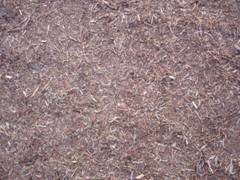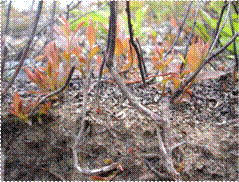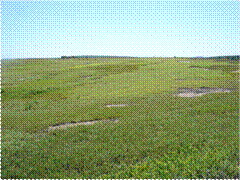Wild Blueberry Prune and Crop Management Schedule
Prepared by David E. Yarborough, Extension Blueberry Specialist, The University of Maine, Orono, ME 04469. February 2010.
Prune Year Management Schedule
| Timing |
Type of Action |
Action |
| April |
 |
Plant Development |
Dormant – new plants not yet emerged. |
| Plant Care |
Prune plants to within 1 inch of ground by mowing or burning (prior year late fall to before bud break). Apply fertilizer preemergence according to leaf sample recommendations (after frost is out of ground prior to plant emergence or shortly after). |
| Weed Control |
Apply preemergence herbicides prior to plant emergence. Apply sulfur according to soil recommendations (after frost is out of ground prior to plant emergence). |
| May |
 |
Plant Development |
Plants beginning to emerge after pruning. |
| Plant Care |
Prune plants to within 1 inch of ground by mowing or burning (prior year late fall to before bud break). Apply fertilizer preemergence according to leaf sample recommendations if not applied earlier (after frost is out of ground prior to plant emergence or shortly after). |
| Weed Control |
Apply preemergence herbicides prior to plant emergence if not applied earlier. Apply sulfur according to soil recommendations not applied earlier (prior to plant emergence). |
| Insect Control |
Use a sweep net to sample for spanworm and flea beetle larvae (end of May) – apply control measures if counts exceed the threshold. Watch for late emerging plants which may indicate insect feeding below the surface. |
| June |
 |
Plant Development |
Plant stems in vegetative growth. |
| Weed Control |
Apply selective postemergence herbicides to weeds at 4 to 6 inches in height. |
| Insect Control |
Use a sweep net to sample for spanworm and flea beetle larvae – apply control measures if counts exceed the threshold. Scout and trap for thrips – burn patches early or apply control measures timed to plant emergence according to recommendations. |
| July |
 |
Plant Development |
Plant stems in vegetative growth to tip-die backstage. |
| Plant Care |
Take leaf samples for nutrient tests at tip-die backstage – take soil samples for Ph. |
| Weed Control |
Apply selective postemergence herbicides to weeds before they go to seed. |
| Insect Control |
Use a sweep net to sample for flea beetle adults and scout for red-striped fireworm – apply control measures if counts exceed the threshold. |
| August |
 |
Plant Development |
Plant stems developing buds for crop year growth. |
| Weed Control |
Wipe nonselective postemergence herbicides on weeds taller than blueberries. |
| Fall |
 |
Plant Development |
Plant stems developing buds for crop year growth and leaf drop occurs after killing frost. |
| Weed Control |
Wipe nonselective postemergence herbicides to weeds taller than blueberries not applied earlier. |
Crop Year Management Schedule
| Timing |
Type of Action |
Action |
| April |
 |
Plant Development |
Dormant – new plants dormant buds begin to swell. |
| Insect Control |
Use a sweep net to sample for spanworm larvae – apply control measures if counts exceed the threshold. |
| May |
 |
Plant Development |
Buds break, bloom and new leaf growth. |
| Plant Care |
Place beehives in the field at about 10% bloom. |
| Disease Control |
Monitor temperature, moisture, mummy berry spore production – apply fungicide to protect plants from mummy berry infection if severity rating is high. |
| Insect Control |
Use a sweep net to sample for spanworm and flea beetle larvae – apply control measures if counts exceed the threshold. |
| June |
 |
Plant Development |
Flowers pollinated and fruit development begins. |
| Plant Care |
Remove beehives from fields after bloom is finished. |
| Disease Control |
Monitor temperature, moisture, mummy berry spore production – apply fungicide to protect plants from mummy berry infection if severity rating is high. Monitor for leaf spot diseases and apply control measures if needed. |
| Insect Control |
Use a sweep net to sample for spanworm and flea beetle larvae – apply control measures if counts exceed threshold observe bee cautions. Place blueberry maggot fly traps in the field at the end of June. |
| July |
 |
Plant Development |
Fruit size increases and begins to turn blue. |
| Plant Care |
Harvest begins in southern part of the state the last week. |
| Disease Control |
Monitor for leaf spot diseases and apply control measures if needed. |
| Insect Control |
Monitor blueberry maggot fly traps and apply control measures if threshold levels are reached. |
| August |
 |
Plant Development |
Fruit continues to ripen and begins to fall off. |
| Plant Care |
Harvest when most fruit is ripe and before fruit drop (harvest from last week of July to end of August – can continue into September if temperatures are cool and the crop is large). |
| Insect Control |
Monitor blueberry maggot fly traps and apply control measures if threshold levels are reached (early August) stake out thrip infested areas of the field for next year control with insecticides or delayed burn. |
| Fall |
 |
Plant Development |
Leaf drop occurs after killing frost. |
| Plant Care |
Prune plants by mowing or burning after the first frost until snowfall. |
| Weed Control |
Wipe nonselective postemergence herbicides to weeds taller than blueberries until leaf drop. Apply bunchberry control up to the first frost. |
NOTE: This schedule gives an overview of the most common production practices. See the fact sheet section for details on these practices.
Information in this publication is provided purely for educational purposes. No responsibility is assumed for any problems associated with the use of products or services mentioned. No endorsement of products or companies is intended, nor is criticism of unnamed products or companies implied.
© 2010
Call 800.287.0274 (in Maine), or 207.581.3188, for information on publications and program offerings from University of Maine Cooperative Extension, or visit extension.umaine.edu.
The University of Maine is an EEO/AA employer, and does not discriminate on the grounds of race, color, religion, sex, sexual orientation, transgender status, gender expression, national origin, citizenship status, age, disability, genetic information or veteran’s status in employment, education, and all other programs and activities. The following person has been designated to handle inquiries regarding non-discrimination policies: Director of Equal Opportunity, 101 Boudreau Hall, University of Maine, Orono, ME 04469-5754, 207.581.1226, TTY 711 (Maine Relay System).












